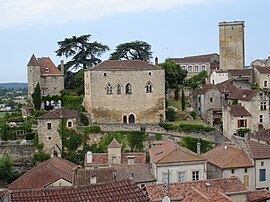Le Cayrou
| Puy-l'Évêque | ||
|---|---|---|
| Commune | ||

View of Puy l'Évêque
|
||
|
||
| Coordinates: 44°30′20″N 1°08′20″E / 44.5056°N 1.1389°ECoordinates: 44°30′20″N 1°08′20″E / 44.5056°N 1.1389°E | ||
| Country | France | |
| Region | Occitanie | |
| Department | Lot | |
| Arrondissement | Cahors | |
| Canton | Puy-l'Évêque | |
| Intercommunality | Community of the Communes of the Lot Valley and Vignoble | |
| Government | ||
| • Mayor (2008–2014) | Serge Guérin | |
| Area1 | 26.38 km2 (10.19 sq mi) | |
| Population (2008)2 | 2,213 | |
| • Density | 84/km2 (220/sq mi) | |
| Time zone | CET (UTC+1) | |
| • Summer (DST) | CEST (UTC+2) | |
| INSEE/Postal code | 46231 /46700 | |
| Elevation | 80–284 m (262–932 ft) (avg. 86 m or 282 ft) |
|
|
1 French Land Register data, which excludes lakes, ponds, glaciers > 1 km² (0.386 sq mi or 247 acres) and river estuaries. 2Population without double counting: residents of multiple communes (e.g., students and military personnel) only counted once. |
||
1 French Land Register data, which excludes lakes, ponds, glaciers > 1 km² (0.386 sq mi or 247 acres) and river estuaries.
Puy-l'Évêque is a commune of France situated in the Lot department, within the Occitanie region. The town is picturesquely situated at the neck of a long loop of the Lot in Quercy on the D811 between Fumel and Cahors, at the center of the Cahors (AOC) wine region.
The origins of the town are obscure. Though vestiges of a Roman road have been discovered running through it, there is no mention of the town until the Middle Ages. It was a Cathar stronghold before the Albigensian Crusade; in 1228 the warrior Bishop of Cahors, Guillaume de Cardaillac, took possession of it and gave it the present name of Puy-l’Evêque, "Bishop's Hill". From then on, it remained under the control of the Count-Bishops of Cahors. Puy-l'Évêque suffered considerably in the Hundred Years' War when it was occupied for a time by the English. In 1580, during the Wars of Religion, it was besieged unsuccessfully by the Protestants under the future King Henri IV; the marks of his cannonballs can still be seen in the main church of Saint-Sauveur.
With the French Revolution the rule of the Count-Bishops ended and the town briefly took the name of 'Puy Libre'. In the period of prosperity that followed the Napoleonic Wars the town was transformed. The 1830s and 1840s saw the construction of the first bridge over the Lot, and the building of the Route Nationale 111 (now D811), the first good road connection to the outside world. A branch railroad line arrived in 1869.
The name Puy-l'Évêque (in Occitan: Pèg l'Avesque) is formed from Puy, a French version of the Occitan word pèg or pech, derived from the Latin word podium, in the sense of being raised to a height. L'Évêque indicates that this came under the suzerainty of the Comte-Évêque of Cahors: Guillaume de Cardaillac1.
...
Wikipedia



